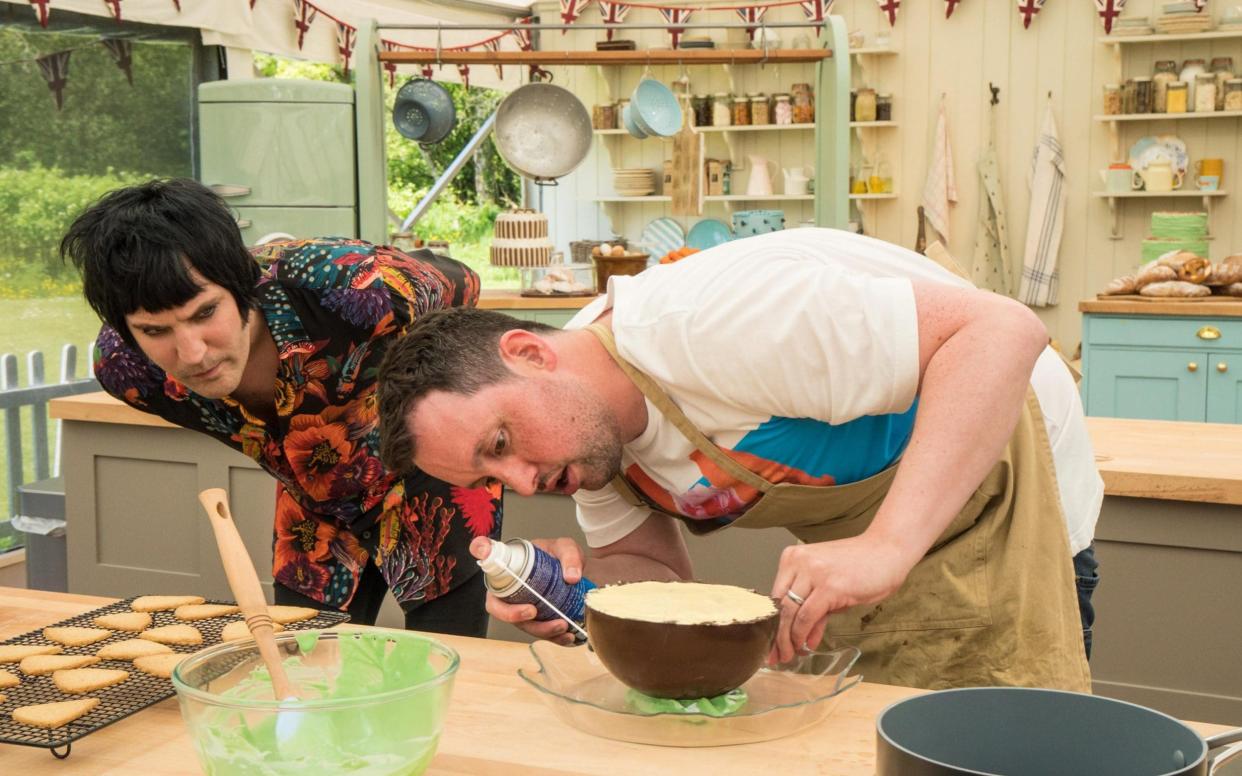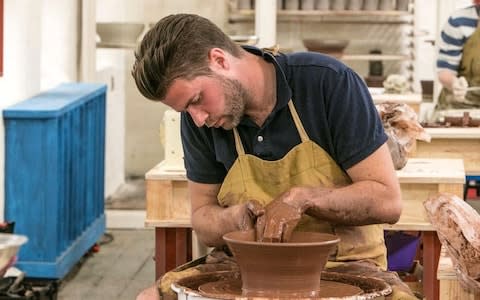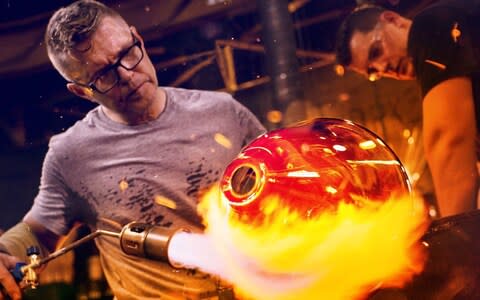10 years after Bake Off’s birth, why we still can’t get enough of twee TV

There is something delicious about watching experts shape objects with their hands. Such is the allure of Blown Away, the new Netflix series where 10 glass blowers mould, burn and twist molten glass into sculptures in the hopes of winning a trophy. Blown Away is one of many craft-based reality shows filling our screens, from The Great British Bake Off and The Great Pottery Throwdown to The Big Painting Challenge and The Great British Sewing Bee. These productions have much in common; they focus on artisanal skills that have long fallen out of favour; the presenters are forgiving and warm; contestants support each other and they are acutely British, with the sets often featuring Union Jack bunting, chintzy crockery and floral tablecloths. Or, in the case of US-based production Blown Away, a rugged warehouse that references America's Industrial heyday.
What does the popularity of these shows tell us about our current political moment? Perhaps they prefigure our attempts to understand our national identity during immense political upheaval. Or maybe we have just looked at too many EdExcel spreadsheets or thumbed too many phone screens, leaving us craving the feeling of dried clay crumbling under our nails, sewing needles pricking our fingertips and thick red paint splodging against a canvas.
The first iteration of this format was The Great British Bake Off, which Love Productions spent four years trying to sell before BBC2 finally picked it up in 2009. Their pitch was repeatedly rejected by TV commissioners who felt that watching cakes bake would be no better than watching paint dry.
But the show became a mammoth success. This year marks a decade since Bake Off began, and in that time it has essentially become the Premier League for those who like flapjacks, with viewing figures peaking during season three at 7.2 million (that's more than double Love Island’s record).
Such homespun competitions are not even just dominating the airwaves, but expanding online, too. When the BBC axed Pottery Throwdown there was a Change.org petition demanding they reconsider. Sewing Bee prompted an explosion in home dressmaking. And people got so into the celebrity version of Painting Challenge that they took to Twitter to express their rage when interior designer Laurence Llewelyn-Bowen was “robbed” of the top prize.
Before Bake Off we were hooked on far crueller reality TV: Big Brother's Nasty Nick playing housemates off against one another; a woman punching her sister in the jaw after their X Factor performance went awry; a man in shutter shades body popping to a jeering Britain's Got Talent audience.
We could cope with all that hostility back in the early 2000s because we were living through far easier times: the government was relatively stable, we still had public libraries and the information economy seemed as if it would steam roll us into the future.
But now, in far gloomier and uncertain times, all this nastiness proves too much to stomach. No wonder, then, that last year X Factor’s viewing figures reached a record low of 3.7 million viewers, Big Brother has been cancelled and the only time anyone watches Britain's Got Talent is when it appears in GoggleBox (another cosy fascination that has thrived in recent years).
The popularity of these homespun shows, though, has also arisen from how immensely satisfying they are to watch. On Bake Off, buttercream becomes the cement in an edible princess castle. On Pottery Throwdown fingers glide wet clay into a gently curving plant pot inspired by the female form. On Sewing Bee sheaths of fabric become square-shouldered blazers. On Blown Away molten glass in fiery oranges and oceanic blues melts down and sticks against different surfaces like stringy mozzarella. It’s essentially ASMR for those who still don’t understand how to work YouTube.
These shows are pleasurable for the same reason people buy vinyl or read books instead of their Kindle: we miss feeling things. In 2017, researchers from the Royal Society of Arts said “digital natives” – the generation born between 1988 and 1998 who were raised on technology – have a desire to produce something material and engage with skills society has lost touch with. Lumbered with bleak career trajectories and worse housing prospects, it’s little wonder millennials seek to return to the simpler times our grandparents inhabited. Given that they are probably too busy working late on a Powerpoint to make some actual pottery, at least they can watch someone else getting their hands dirty.

The presenters on these shows are often refreshingly kind, especially when compared with the nasty put-downs we normally expect from game shows, such as Simon Cowell asking a big Britain’s Got Talent gospel singer auditionee where the rest of his choir is: “Did you eat them all?” Or Alan Sugar pointing and yelling, “You’re fired!”
When the sponge doesn’t rise, former judge Mary Berry is sad more than anything else, as though the cake were a puppy born without a heartbeat. Host Sara Cox strolls around the Pottery Throwdown studio chatting about her favourite crisp flavours or asking contestants where they are holidaying next year. On series four of Sewing Bee, Jade wrongly thinks the inside lining should be showing around the collar and sleeves of her traditional Chinese Hanfu top. Rather than letting her be eliminated for misunderstanding the instructions, judge Patrick Grant explains her mistake so she can unpick it all and start again. “We wrote it in English as well,”' laughs Patrick.
It’s nice to watch people be nice. We are becoming so accustomed to the soft touch of these programmes that when Painting Challenge judges Daphne Todd and Lachlan Goudie were caustic about contestants paintings, viewers became furious. The judges had left Oliver deflated and teary-eyed after calling his interpretation of a gymnast in motion “trite” and lacking in “soul”, and another contestant visibly cowered when they said her somersaulting gymnast looked like a “gender-fluid orgy”.
“No one should enter #bigpaintingchallenge people's self-confidence is being destroyed”, tweeted @flutterbyfavs. “Making art is about the joyful process not the end product -shame on this program and the judges. Art is about enjoyment, selfexpression, emotional release & wellbeing. Art is not a competition.”

It’s not just the presenters though – the contestants on these shows are kind to each other too. Bake Off is perhaps the prime example: rivals lend one another sieves and help turn over each other’s brioche rolls. During season eight’s biscuit week, Tom was struggling, falling behind with Amaretto Kisses that required two different layers of contrasting icing piped onto coffee biscuits. Seeing his shaky hands and clenched jaw, Steven and Stacy abandoned their own workstation to help him plate up. Meanwhile, by contrast, in The Apprentice boardroom, women in stiff pink shift dresses blame each other for not haggling down the price of the ostrich sausages as competitively low as the other team.
These shows are calming because their stakes are low: the only jeopardy is whether the centre of the chocolate fondant will solidify or the clay cracks in the kiln or the glass sculpture shatters after cooling down too quickly. Contestants are not necessarily looking to launch themselves into superstardom (if they do get a bestselling publishing career out of it like Nadiya Hussain it’s more of a happy accident). During the final they will jump for joy even if the winner is not them. And though what they make might go horribly wrong, the judges will probably tell them they have potential anyway.
In turbulent times, such quiet competition is a pleasure to watch. We seek refuge from our knowledge of environmental disaster, the housing crisis and the bitter reality that Brexit has become a fiction no-one understands. Instead, we can watch men with beards smooth glass bowls with cloths until they are shiny and perfect. A world where people are nice to each other even when they want the same thing.

The majority of these shows plug straight into quaint British ideals, both in the set design and in the crafts themselves. The original inspiration behind Bake Off was rural baking competition at a village fete. And the producers felt baking said much about Britain’s regional peculiarities, from fat rascals to bara brith to parkins. Pottery has been a British pastime since Wedgwood; sewing brings to mind ladies in stately homes needling embroidery hoops under cumbersome bonnets and in Painting Challenge, they paint Stubbs-style horses.
Meanwhile, Blown Away’s steel pipes, exposed brick and hot furnaces recall the Industrial Revolution when factories full of glass artisans emerged all over America. It’s as though we are trying to understand our identity as we become untethered from the EU. Or, as in the case of Blown Away, people attempt to conceive an American identity that doesn’t involve drifting towards the far right.
No wonder we continue to favour reality shows that are as soft and light as a lemon drizzle cake. Gone are the days when we enjoyed watching Dermot O’Leary bringing on stage a boyband of 14-year-olds with sweeping side fringes to sing for their lives. Who wants the drama and upset when they are eliminated and cry into Cheryl Cole’s perfect caramel brown hair extensions? We crave something to make us feel warm and fuzzy inside. It will be a nice distraction to see someone in a frilly apron kneading sourdough bread when the Earth bursts into flames.

